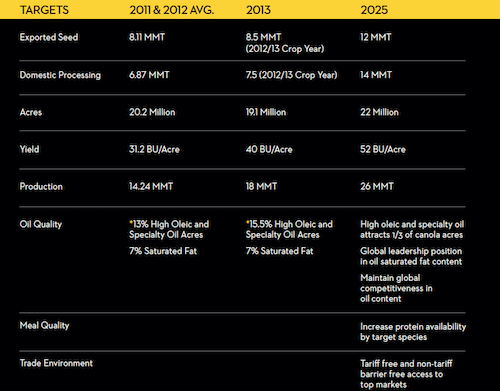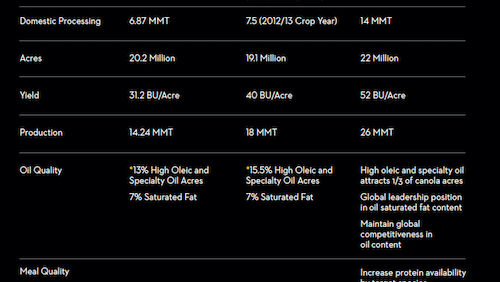
Canadian canola production surpassed the industry target of 15 million tonnes. The next goal, announced today, is 26 million tonnes by 2025. This is based primarily on an increase in yield per acre, with very little increase in overall acres of canola. An average Canadian yield of 52 bu./ac. over 22 million acres will achieve 26 million tonnes of production.
The Canadian canola industry is aiming to grow annual demand to 26 million tonnes by 2025, based on global growth trends in vegetable oil consumption and the rapid rise in demand for healthier alternatives like canola oil. These trends show that the market will be there, and the challenge for Canada is to seize the opportunity rather than leaving it to some other country. By laying out a framework for growth, the Canola Council of Canada and its members believe that the new 2025 strategic plan will help to spur on the development of the logistical infrastructure, domestic crush capacity and agronomic advancements to achieve this goal.
Genetic gain alone could contribute 10 bu./ac. to the current 40 bu./ac. average achieved in 2013. Agronomy and management practices could contribute another 10 bu./ac. as follows:
—Plant establishment. Yield gains of 3 bu./ac. can be realized by a better understanding of seed mortality and seed placement with the goal of consistently reaching plant stands that lead to top yields.
—Fertility Management. A small magnitude increase in fertility to meet the
full nutritional requirements of the crop could contribute 3 bu./ac. to yields by 2025.
—Pest Management. Yield gains of 2 bu./ac. can be realized through improved management of weeds, diseases, and insects.
—Harvest Management. Research shows that we are losing 2 to 5 bu./ac.
at harvest. Improved swathing timing and adoption of straight cutting could reduce average losses by 2 bu./ac.
This new goal will require new agronomy tactics. Going forward, the Canola Council of Canada will implement an approach that recognizes that each farm operation is unique and that growers need to make their own decisions depending on their own circumstances. Canola agronomy cannot be a “one size fits all” approach. For example, some farms will be able to sustainably use a one in two canola rotation. Others may need to use a longer rotation, perhaps due to high blackleg severity and incidence, increased flea beetle populations, positive clubroot identification and herbicide tolerant weeds. The role of the Council is to ensure growers have the best information based on the latest science. We will respond to each grower’s unique circumstances, in order to maximize production from every single seed of planted canola.
For more on the strategic plan, please visit the website at keepitcoming.ca
For more on the agronomy plan: Keep it Coming 2025 – The Science[2].

